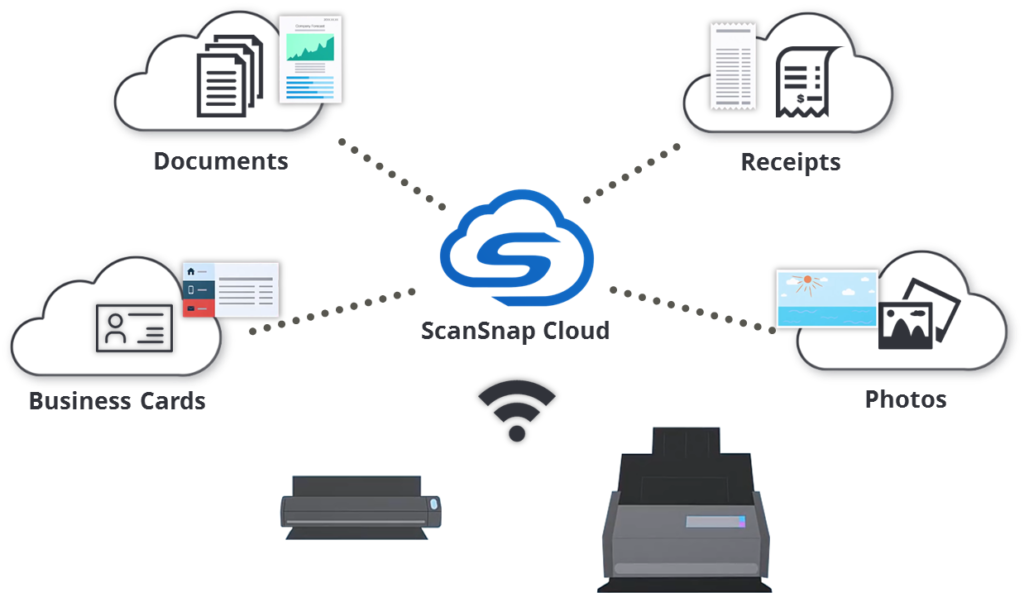My regular readers know how enthusiastic I am about using Fujitsu’s amazing ScanSnap series of scanners. I have pretty much used every scanner they make, and I often take my iX100 mobile scanner with me when I have tech organizing appointments. Naturally I was very excited to hear that I would get a chance to test drive Fujitsu’s latest offering, ScanSnap Cloud. This great new app enables you to scan documents, receipts, business cards and photos using one of Fujitsu’s two wireless scanners, the iX100 or the iX500, without the scanner being connected to (or anywhere near!) a computer. Here’s how it works:
After downloading the ScanSnap Cloud software to your computer – I put it on both my MacBook Air and my (ancient) iMac – you can go to the app’s Preferences tab, choose Settings and indicate where you want each type of output file to be saved “automagically.” You can use ScanSnap’s own cloud-based service to store your files, or you can send them to another cloud-based account that you already have. ScanSnap has teamed up with several major cloud-based storage apps including Dropbox, Evernote, Google Photos, Google Drive, Expensify and One Drive, so you’ll have plenty of options. If you use one of the other storage services, you’ll need to give the ScanSnap app permission to access your account. But you’ll only have to do that once; after it’s been set up, ScanSnap will be able to store files using your other accounts without any further action on your part.
Scanned files are classified into four categories: documents, receipts, business cards and photos. You can choose where images should be saved depending upon their category. For example, I decided I wanted my business cards in Evernote, my documents (MS Word and PDF files) in Dropbox and my photos in Google Photos.
You’ll know when ScanSnap Cloud is working since the normally blue light on the scanner will turn a lovely purplish color. All you have to do is press the purple button, and the scanning starts and finishes on its own. You can easily go back and forth between scanning to the cloud and scanning directly to your computer using your existing ScanSnap Manager settings. On my computer, documents go directly into a Dropbox folder called ScanSnap, so that I can manipulate them later.
The other cool feature that ScanSnap Cloud provides is the ability to automatically name each output file, using whatever information it can find in the image or document and adding a date. This can be very helpful, but you’ll need to check to make sure the app is selecting the right information for naming the file. For instance, when I scanned a credit card statement, rather than pulling the name of the credit card, the app selected the words with the largest font, in this case “Less Waste” – i.e., the vendor’s recommendation that I go paperless. However, even if the software gets the name wrong, it’s very easy to rename files from within the ScanSnap Cloud app and then put them exactly where you want them to go.
There are a lot of useful applications for ScanSnap Cloud. For example, I have many clients with enormous amounts of paper who just want to scan it all quickly, but don’t have time for making immediate decisions about how the output should be filed. With ScanSnap Cloud, they can scan a whole pile of mixed documents and then go back into the app later (when they have the time) to rename the files and put them in the right folders. Also, if you need to scan when you are away from your home or office and don’t have your computer nearby, you can use the extremely portable iX100 scanner to send your output files to the cloud, knowing that they’ll go right where you want them to be.
Overall, I find that the new ScanSnap Cloud has the ability to make scanning even easier and more accessible to people who want to make going paperless a part of their lives.
Visit ScanSnapCloud.com to download ScanSnap Cloud.



4 thoughts on “Introducing a new way to scan with ScanSnap Cloud”
Wow, this sound like an amazing tool!
It makes scanning with a ScanSnap even easier, if that’s possible!
Thanks so much for this resourceful post Penny! I have a ScanSnap but haven’t used it as effectively as I should. I am going to see if this works for me. 🙂
Thanks Autumn! Happy to walk you through any ScanSnap workflows remotely any time!